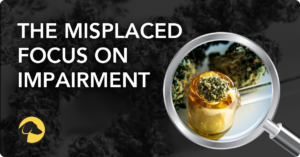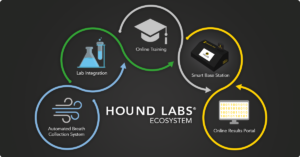
The Safety and Cost Benefits of Reasonable Suspicion Testing
Reasonable suspicion drug testing, often referred to as for-cause or probable cause testing, is a targeted screening method implemented to assess an employee suspected of using drugs or alcohol during work hours. Unlike random testing, which is conducted without a specific cause, reasonable suspicion testing is performed only when a manager or co-worker directly observes unusual behavior, symptoms, or possession of items that could indicate substance use in the workplace. Even in states where recreational marijuana is legal, employers can leverage this testing method to deter and detect cannabis use immediately before or during the workday.
Drug testing experts provide important guidance for employers to consider when implementing this testing method. Here, we explore the objectives of reasonable suspicion testing, applications for this testing method, and the benefits it can bring to the workplace.
OBSERVATION
Reasonable suspicion testing is conducted based on the immediate and direct observation of an employee exhibiting signs of substance use. Rather than basing action on rumor or hearsay, supervisors observe the behavior themselves and then confirm any suspicions with at least one other supervisor or manager.
In observation, supervisors are advised to note objective facts that might suggest that the individual in question could be in violation of company policy related to substance use in the workplace. These signs generally fall into three categories: physical signs such as movement and appearance, behavioral signs such as productivity and responsiveness, and psychological signs such as irritability and lack of focus.
The following is a general list of indicators to reference in observation:
- Observable behavior – including sudden erratic behavior or changes in an employee’s demeanor over time
- Performance issues at work – a decline in the person’s usual job performance, increased absenteeism, or frequent tardiness
- Physical signs – including but not limited to dilated pupils, bloodshot eyes, or slurred speech
- Neglect of personal hygiene – a disheveled appearance or a sudden change in grooming habits
- Shifts in their established patterns – such as drastic changes in work habits, social interactions, or personal relationships
DOCUMENTATION
Enforcing reasonable suspicion testing can come with its own set of challenges. The indicators prompting reasonable suspicion testing are often subjective and open to interpretation – especially in the era of cannabis legalization. For these reasons, documentation represents a critical element in effectively deterring and detecting cannabis use in the workplace. Documentation helps ensure employers take the right steps for both testing and follow-up as outlined in the company drug testing policy. It can also provide supporting evidence as the basis for warranted adverse employment action, should it be necessary.
From the moment an employee exhibits signs of potential substance use, all information related to the situation – including the date and time, the specific indicators observed, and the names of the employee and observers – can provide documented evidence in support of testing. Information such as company policies, employee handbooks, corroborating witness accounts, and employee responses can also be helpful references and filed in support of the record.
EDUCATION
If documentation is one of the keys to success, another is education. As with any drug testing policy, effectiveness hinges greatly on the degree to which employees understand what the policy says and how it will be applied. The first step is establishing a clear and comprehensive written policy that prohibits workday substance use and spells out the company’s approach to testing, including methods such as reasonable suspicion and sample types such as breath.
The next step is educating employees on the policy, providing written notice of any changes, and reinforcing it as a standard to be consistently applied among all employees. Details such as when reasonable suspicion testing will be applied, the types of observations that might prompt it, and how it will be conducted can help employers avoid any surprises when it comes to enforcement. Policies can also detail the outcomes of positive test results and provide information about stand-down procedures, second-chance opportunities, Employee Assistance Programs (EAPs), and treatment programs.
Creating policies to help facilitate a safe workplace while also maintaining employee privacy can be a delicate balancing act. Some may view reasonable suspicion testing as an invasion of privacy, leading to resistance and challenges when employees are informed about this testing policy. Training supervisors and managers to recognize and consistently document indicators and how to take appropriate action in response can be critical to support effective policy enforcement and help avoid potential wrongful termination or discrimination lawsuits.
APPLICATION
Reasonable suspicion testing programs were initially designed for on-site job settings, and primarily for safety-sensitive roles. Many programs were established before the rise in remote work, and in some cases before testing programs were extended to apply beyond the scope of positions traditionally considered safety-sensitive.
During the pandemic, however, evidence began to suggest that remote and hybrid work contributed to the increasing use and abuse of drugs and alcohol while on the job – and in settings out of view of co-workers and supervisors. A survey commissioned by an Arizona-based mental treatment center reported that 20% of U.S. workers admitted to using recreational drugs while working remotely and 22% of employees surveyed admitted to participating in a virtual work call while under the influence of marijuana, alcohol, or other recreational drugs.
This scenario introduces new challenges for employers in monitoring employee behavior. Traditional visual indications of potential use may be absent in virtual settings. However, the potential consequences of on-the-job substance use remain, making reasonable suspicion testing an essential tool for promoting a safe and productive work environment.
For remote workers, signs that may alert employers to substance abuse issues include:
- Distant/irritable conduct during meetings/evaluations
- Dramatic inconsistencies in work product
- Mistakes in judgment
- Lack of punctuality or inconsistent clock-ins
- Vague excuses/complaints to justify behavior
- Refusal to turn on the camera during remote meetings
- Decreased responses or changes in communication patterns
- Consistent lack of availability
In both on-site and virtual scenarios, reasonable suspicion testing provides a standardized approach, enabling organizations to address substance use concerns consistently across different locations, ensuring compliance with varying legal landscapes.
VALUATION
As companies implement reasonable suspicion testing, a recent use cannabis breath test can be used to support employer observations of the signs of potential workday cannabis use. With a breath test, employers can objectively determine if an employee has recently used cannabis, either by ruling out the drug or confirming it as a potential factor influencing employee behavior.
A cannabis breath test for recent use provides the following benefits:
- Objective results – supports reasonable suspicion determinations with objective results
- Fair testing policies – allows employees to return to work should results indicate past use not directly impacting the workday
- Employee support – provides a tool for employers to use in conjunction with additional drug testing, medical evaluation, and mental health support
Cannabis breath testing can enhance the effectiveness of reasonable suspicion drug testing programs, helping employers mitigate the risks of workplace incidents, deter workday use, and reduce costs related to workday use.
Click here to learn more about policy considerations when implementing cannabis breath testing. To discuss bringing recent use breath testing on board at your organization, reach out to one of our experienced team members.

March 7, 2024
By AARON ATKINSON
EXECUTIVE VICE PRESIDENT OF MARKETING
Share











